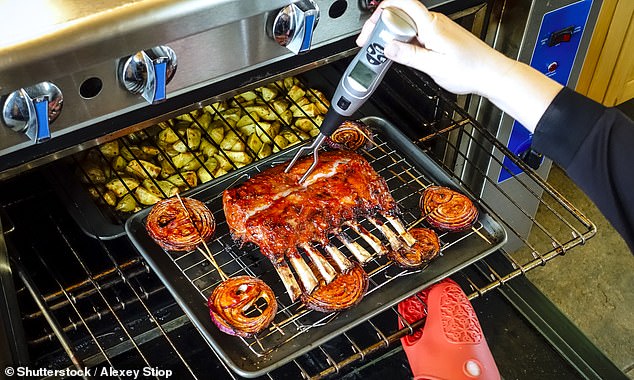Food scientist reveals the nine mistakes you’re making in the kitchen
>
Have you ever feared you’ve cooked more than you expected in the kitchen, with foodborne illness a common problem?
The US Centers for Disease Control and Prevention estimates that each year, 48 million people get sick from contaminated food or drink. Meanwhile, 128,000 are hospitalized and 3,000 die from deadly germs.
If you’re looking to keep things clean in the kitchen and avoid bouts of diarrhea, nausea, or vomiting, New York-based food scientist Robert Gravani has some top tips.
The food science professor at Cornell University shared with hoy.com nine of the biggest mistakes people make when it comes to kitchen hygiene. Bite your way down to see how you can clean up your act.
New York-based food scientist Robert Gravani has revealed the nine riskiest hygiene mistakes people make in the kitchen.
1. Skipping hand washing before eating or cooking
Many people forget or neglect to wash their hands before eating or cooking, Gravani says, while highlighting this as “rule number one” when it comes to kitchen prep.
While handwashing has long been practiced by food safety professionals, hobby cooks were less aware of it until the pandemic hit and taught people about the spread of bacteria.
Good hand-washing etiquette is essential, Gravani says, to avoid cross-contamination and is particularly important when it comes to handling raw meats. To ensure maximum cleanliness, she recommends washing your hands thoroughly with soap and water for at least 20 seconds.

Many people forget or forget to wash their hands before eating or cooking, Gravani says while highlighting this as “rule number one” when it comes to kitchen prep.
2. Wash raw poultry in the sink before cooking.
While many people think they should rinse raw meat with water before cooking it, Gravani says this is an exercise in futility.
While raw poultry does contain bacteria like salmonella and clostridium, the food expert says they’re all killed when the meat is cooked properly.
When washing meat, you can actually increase the risk of contamination, as water droplets spread bacteria to other areas of the kitchen.
3. Forgetting to rinse fruits and vegetables
While raw meat doesn’t need to be washed before cooking, rinsing fresh fruits and vegetables is a must.
Gravani recommends using clean running water to remove any dirt or debris covering the product.
Then, to dry things up, use a paper towel that can be thrown away.
“Do not use soap or detergent,” warns the professor, who reveals that soap residue can make people sick.
4. Using the same utensils from start to finish when cooking raw meat or seafood
Gravani cautions against using the same utensils from start to finish when it comes to meat.
He says people commonly do this when preparing dishes like bolognese, where they break up the raw ground meat with a spoon and use the same utensil to stir it as it cooks and serve it as a sauce.
The culinary genius reveals that disease-causing bacteria in raw meat and seafood can permeate ingredients after they’ve been cooked. For this reason, he advises using new utensils during the cooking process or washing them well at each step.
5. Grab spices while handling raw meat
“When you’re preparing raw foods or meat, you’re often going to reach into the spice container and sprinkle it on,” says Gravani.
But he notes that as a result of this, spice containers could be cross-contaminated with raw meat.
If you put the spice jars back in the cabinet without washing, then other items could be infected as well.
To prevent this from happening, Granvani suggests measuring the spices onto a small plate before the cooking process begins.
6. Using your eyes instead of a meat thermometer.
A big mistake hobby chefs make, Gravani says, is trying to guess when raw meat or seafood is cooking just by looking at it. He stresses that a good quality thermometer will help eradicate all nasty organisms.
“Research has shown that you can’t tell if a food is fully cooked just by looking at its color or texture,” Gravani explains.
When it comes to required temperatures, the USDA says the following foods should be cooked to minimum internal temperatures: beef to 145 degrees Fahrenheit, poultry to 165 degrees Fahrenheit, eggs to 160 degrees Fahrenheit, and fish or shellfish to 145 Fahrenheit degrees.

A good quality thermometer will help eradicate all the nasty organisms, says Gravani.
7. Wait more than two hours to store cooked food in the refrigerator
If you have leftovers or perishable foods, Gravani recommends getting them in the fridge as soon as possible and within two hours.
However, if the room temperature is above 90 degrees Fahrenheit, he says leftovers should be refrigerated within an hour, as bacteria will grow faster.
As for storing food in the fridge, Gravani recommends dividing leftovers into small containers to help them cool faster. It also stresses the importance of setting the refrigerator at 40 degrees Fahrenheit or below, and reheating food to 165 degrees Fahrenheit, per USDA guidelines.
8. Eating leftovers that have been in the fridge for more than four days
Have you ever risked eating leftovers that have been sitting in your fridge for several days or more? Well, Gravani describes this as a recipe for disaster, as bacteria and toxins quickly spread.
He says you can’t tell if food is safe by looking at it or smelling it. He advises throwing out leftovers after four days of being in the fridge or if in doubt.
To help you keep track of how long ingredients have been on the shelf, Gravani suggests writing the dates on the containers or using labels.
9. Eating risky foods raw or undercooked if you are at high risk
Gravani says that if you’re at high risk or prone to getting sick, it’s best to avoid eating raw or undercooked foods, such as steak tartare, oysters, or even runny eggs.
He says that he himself does not eat any of these foods. While he points out that these foods could be contaminated, he says “most of them aren’t,” but he likes to err on the side of caution.
He highlights that the people most vulnerable to foodborne illness are adults over the age of 65, children under the age of five, pregnant women, and people with compromised immune systems or underlying health conditions.
